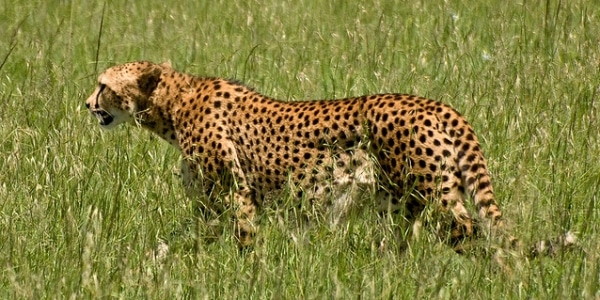Hunting Cheetahs Depend On Agility Rather Than Speed
The cheetah is known as being the fastest land animal on the planet however these elegant big cats actually depend on their ability to rapidly accelerate and manoeuvre around turns which are extremely tight when it comes to hunting according to the results of a new study. The study looked at five cheetahs in the wilderness of Northern Botswana and found that despite reaching speeds as fast as 97 km/h, the animals relied more on their agility then their ability to reach a fast pace to take down their prey.
Cheetahs don’t always reach top speed
Dr. Alan Wilson, the lead researcher says that whilst the cheetah can reach a very high top speed they don’t always do so. Dr. Wilson and his team designed a unique GPS tracking device which was attached to a collar for their cheetah subjects. The device recorded precise data such as acceleration, deceleration, location and speed. The study lasted for 17 months tracking 367 runs and found a top speed of 93 km/h though in most cases the cheetahs kept a more moderate pace recording an average speed of 50 km/h.
“They’re doing about half their top speed, so they’re not moving extremely quickly when they hunt,” Dr. Wilson said.
The chase begins with stalking
Using the GPS tracking device, the researchers collected information which enabled them to map out the running behaviour of hunting wild cheetahs. They found that runs usually begin with acceleration either from stationary or slow movement, which suggests the animals were stalking their prey. The cheetahs would then decelerate and manoeuvre before capturing their prey.
The fastest and most powerful land animal on the planet
The researchers added that acceleration and turning speeds of the cheetahs either matched or exceeded the known speeds of all other land animals. One astonishing fact is the cheetah has the ability to increase its speed by as much as 10.8 km/h in a single stride. The researchers calculated that the muscle power output of the cheetah during a sustained acceleration is also the highest of any land animal and is approximately four times greater than the exertion of sprinter Usain Bolt when he broke the 100 metre world record in 2009.
Hit and miss success rate when hunting
Whilst the cheetah is fast and agile, it did not always manage to make the kill. Of the 367 run that were looked at, only 94 managed to result in a successful capture of the prey. All things considered that worked out to a success rate of roughly 26 per cent. Nearly half of all chases occurred on open grassland and 28 per cent took place around large trees. 24 per cent of chases happened in areas where there was thick vegetation cover.
Impala is the preferred prey
Whilst it might seem like shrubs and trees may provide cheetahs with a better means to stalk their prey, the researched found there was no significant difference between speeds and distances run across the different terrains. The cheetahs that were being studied tended to hunt impala which is typed of African antelope; however there was one male who seemed to prefer to hunt for warthogs in areas of thick vegetation Dr. Wilson said.


